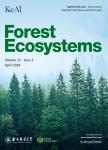An imputation/copula-based stochastic individual tree growth model for mixed species Acadian forests: a case study using the Nova Scotia permanent sample plot network
An imputation/copula-based stochastic individual tree growth model for mixed species Acadian forests:a case study using the Nova Scotia permanent sample plot network作者机构:University of New BrunswickFrederictonNBCanada University of MaineOroooMEUSA Atlantic Forestry CentreNatural Resources Canada.FrederiaooNBCanada Nova Scotia Natural ResourcesForestry DivisionTruroNS B2N 0G9UK.
出 版 物:《Forest Ecosystems》 (森林生态系统(英文版))
年 卷 期:2017年第4卷第4期
页 面:251-263页
核心收录:
学科分类:0710[理学-生物学] 0830[工学-环境科学与工程(可授工学、理学、农学学位)] 0907[农学-林学] 090704[农学-森林经理学] 0829[工学-林业工程] 09[农学] 0901[农学-作物学] 0833[工学-城乡规划学] 0713[理学-生态学] 0834[工学-风景园林学(可授工学、农学学位)]
主 题:Nearest neighbor imputation Copula sampling Individual tree growth model Mortality Ingrowth Mixed species stand development Acadian forests Nova Scotia
摘 要:Background: A novel approach to modelling individual tree growth dynamics is proposed. The approach combines multiple imputation and copula sampling to produce a stochastic individual tree growth and yield projection system. Methods: The Nova Scotia, Canada permanent sample plot network is used as a case study to develop and test the modelling approach. Predictions from this model are compared to predictions from the Acadian variant of the Forest Vegetation Simulator, a widely used statistical individual tree growth and yield model. Results: Diameter and height growth rates were predicted with error rates consistent with those produced using statistical models. Mortality and ingrowth error rates were higher than those observed for diameter and height, but also were within the bounds produced by traditional approaches for predicting these rates. Ingrowth species composition was very poorly predicted. The model was capable of reproducing a wide range of stand dynamic trajectories and in some cases reproduced trajectories that the statistical model was incapable of reproducing. Conclusions: The model has potential to be used as a benchmarking tool for evaluating statistical and process models and may provide a mechanism to separate signal from noise and improve our ability to analyze and learn from large regional datasets that often have underlying flaws in sample design.



